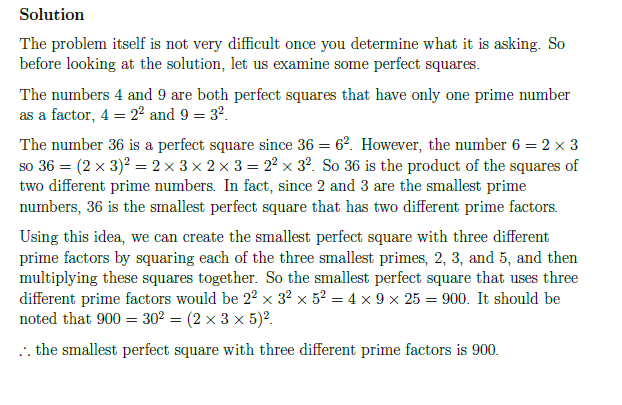Congratulations to all you Gauss contest takers! Special shout-out to Tin and Seayrohn for 1st and 2nd in Grade 7, Vitahi for 2nd on Grade 8, Fred for his PERFECT score in Grade 8, and Edward for finishing 3rd while only in Grade 5!
POTW #32 Question:
POTW #31 Solution:

POTW:
ReplyDeleteInfo:
- BCDE and ACD are equal in area.
- BCDE side length is 12.
- Find BFDC
Since we know that the square and the triangle are the same, we know that triangle ABF and FED are congruent. So, to find the area of the trapezoid, we could subtract the area of the sqaure and the area of the triangle.
Since the square has a side length of 12, we can sqaure it to get the area: 12^2= 144.
To find the area of the triangle, we know that the height is equal to the height of the square and the base is equal to half of 12 (side length): (12*6)/2=36
144-36=108 cm^2.
Grade 7/8 POTW
ReplyDeleteFacts:
- BCDE = ACD
- BC = CD = DE = BE = 12 cm
- Find the area of BCDF
I will get straight to the math. BCDE = ACD and both figures share BCDF. Therefore, ABF and DEF are congruent to each other. We know the area of BCDE is = to 144 cm squared because square area formula = l^2 = 12^2 = 12 x 12 = 144. We know ACD is also 144 cm squared and that the base CD remains 12 cm, therefore, AC has to be 24 cm since triangle area formula = (b x h)/2 = (12 x h)/2 = 144. 144 x 2 = 288. 288/12 = 24. Therefore, the height AC = 24 cm. Because AC is double BC, it means that F is the midpoint of BE. Therefore, the area of the smaller triangles ABF and DEF would have to be ((12/2) x 12)/2 = (6 x 12)/2 = 72/2 = 36. Now we have to take 144 and subtract the unnecessary 36 cm squared. 144 - 36 = 108 cm squared.
The area of BCDF = 108 cm^2
POTW:
ReplyDeleteThis one is pretty simple.
Since both areas are equal, we can calculate the area of the square, which is 12*12 = 144. The triangle ACD would then be 144*2/12 = 24, so the small triangle would have the side length of 12. This can also prove that F is the midpoint so the small triangle that matches up with the quadrilateral to create the square has an area of 6*12/2 = 36. Subtracted, this would give me 108 cm squared.
-Alan
POTW:
ReplyDeleteThe question already tells me that the side length of the square is 12 cm. This already tells us alot. The question also tells me that the area of the square and triangle are the same.
So,
Area of ΔACD = Area of □BCDE
Or:
(L*W)/2 = L*W
To find the length of ΔACD, I can use the equation above:
(L*W)/2 = L*W
(12L)/2 = 12*12
(12L)/2 = 144
12L = 288
L = 24
The length of the triangle is 24 cm.
Now that I have the side lengths of the triangle and square, I can find the area of quadrilateral BCDF.
By looking at the diagram, I can see that the top right triangle's(ΔABF) length is 12 cm. I can also assume that the width is 6cm by dividing the square's length in half.
Area of ΔABF:
(12*6)/2 = 36cm^2
To find the area of quadrilateral BCDF:
144cm^2 - 36cm^2
That gives me 108cm^2
Therefore, the area of quadrilateral BCDF is 108cm^2.
BCDF has an area of 108cm^2
ReplyDeleteI divided the entire shape into triangles equal to Triangle ABF, which got me my measurements
ReplyDeleteBF= 6 cm
CD= 12 cm BC = 12 cm
A = (b1 + b2)/2 * H
A = (BF + CD)/2 * BC
A = (6 + 12)/2 * 12
A = 18/2 * 12
A = 9 * 12
A = 108 cm squared
So we know BF = half of the side length which is 12 cm so
ReplyDeleteBF = S/2
BF = 12/2
BF = 6cm
BCDE = S*S
BCDE = 12*12
BCDE = 144cm2
DEF = (B*H) / 2
DEF = (6*12) / 2
DEF = 72 / 2
DEF = 36 cm2
BCDF = BCDE - DEF
BCDF = 144 - 36
BCDF = 108cm2
Therefore the trapezoid is 108cm2
Quadrilateral BCDF has an area of 108 cm squared. My work was done on paper.
ReplyDelete